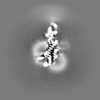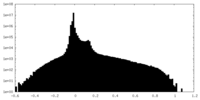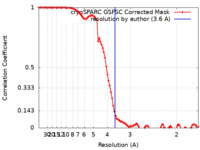登録情報 データベース : EMDB / ID : EMD-34917タイトル Structure of CXCR3 complexed with antagonist SCH546738 複合体 : CXCR3-KOR-SCH546738-Nb6タンパク質・ペプチド : Nb6タンパク質・ペプチド : Soluble cytochrome b562,C-X-C chemokine receptor type 3,Kappa-type opioid receptorリガンド : 3-azanyl-6-chloranyl-5-[(3S)-4-[1-[(4-chlorophenyl)methyl]piperidin-4-yl]-3-ethyl-piperazin-1-yl]pyrazine-2-carboxamideリガンド : CHOLESTEROL / / / / / 機能・相同性 分子機能 ドメイン・相同性 構成要素
/ / / / / / / / / / / / / / / / / / / / / / / / / / / / / / / / / / / / / / / / / / / / / / / / / / / / / / / / / / / / / / / / / / / / / / / / / / / / / / / / / / / / / / / / / / / / / / / / / / / / / / / / / / / / / / / / / / / / / / / / / / 生物種 Homo sapiens (ヒト) / Lama glama (ラマ)手法 / / 解像度 : 3.6 Å Jiao HZ / Hu HL 資金援助 Organization Grant number 国 National Natural Science Foundation of China (NSFC) 32100963
ジャーナル : Nat Struct Mol Biol / 年 : 2024タイトル : Structural insights into the activation and inhibition of CXC chemokine receptor 3.著者 : Haizhan Jiao / Bin Pang / Aijun Liu / Qiang Chen / Qi Pan / Xiankun Wang / Yunong Xu / Ying-Chih Chiang / Ruobing Ren / Hongli Hu / 要旨 : The chemotaxis of CD4 type 1 helper cells and CD8 cytotoxic lymphocytes, guided by interferon-inducible CXC chemokine 9-11 (CXCL9-11) and CXC chemokine receptor 3 (CXCR3), plays a critical role in ... The chemotaxis of CD4 type 1 helper cells and CD8 cytotoxic lymphocytes, guided by interferon-inducible CXC chemokine 9-11 (CXCL9-11) and CXC chemokine receptor 3 (CXCR3), plays a critical role in type 1 immunity. Here we determined the structures of human CXCR3-DNG complexes activated by chemokine CXCL11, peptidomimetic agonist PS372424 and biaryl-type agonist VUF11222, and the structure of inactive CXCR3 bound to noncompetitive antagonist SCH546738. Structural analysis revealed that PS372424 shares a similar orthosteric binding pocket to the N terminus of CXCL11, while VUF11222 buries deeper and activates the receptor in a distinct manner. We showed an allosteric binding site between TM5 and TM6, accommodating SCH546738 in the inactive CXCR3. SCH546738 may restrain the receptor at an inactive state by preventing the repacking of TM5 and TM6. By revealing the binding patterns and the pharmacological properties of the four modulators, we present the activation mechanisms of CXCR3 and provide insights for future drug development. 履歴 登録 2022年12月8日 - ヘッダ(付随情報) 公開 2023年11月29日 - マップ公開 2023年11月29日 - 更新 2025年7月23日 - 現状 2025年7月23日 処理サイト : PDBc / 状態 : 公開
すべて表示 表示を減らす
 データを開く
データを開く 基本情報
基本情報
 マップデータ
マップデータ 試料
試料 キーワード
キーワード 機能・相同性情報
機能・相同性情報 Homo sapiens (ヒト) /
Homo sapiens (ヒト) / 
 データ登録者
データ登録者 中国, 1件
中国, 1件  引用
引用 ジャーナル: Nat Struct Mol Biol / 年: 2024
ジャーナル: Nat Struct Mol Biol / 年: 2024
 構造の表示
構造の表示 ダウンロードとリンク
ダウンロードとリンク emd_34917.map.gz
emd_34917.map.gz EMDBマップデータ形式
EMDBマップデータ形式 emd-34917-v30.xml
emd-34917-v30.xml emd-34917.xml
emd-34917.xml EMDBヘッダ
EMDBヘッダ emd_34917_fsc.xml
emd_34917_fsc.xml FSCデータファイル
FSCデータファイル emd_34917.png
emd_34917.png emd-34917.cif.gz
emd-34917.cif.gz emd_34917_additional_1.map.gz
emd_34917_additional_1.map.gz emd_34917_half_map_1.map.gz
emd_34917_half_map_1.map.gz emd_34917_half_map_2.map.gz
emd_34917_half_map_2.map.gz http://ftp.pdbj.org/pub/emdb/structures/EMD-34917
http://ftp.pdbj.org/pub/emdb/structures/EMD-34917 ftp://ftp.pdbj.org/pub/emdb/structures/EMD-34917
ftp://ftp.pdbj.org/pub/emdb/structures/EMD-34917 emd_34917_validation.pdf.gz
emd_34917_validation.pdf.gz EMDB検証レポート
EMDB検証レポート emd_34917_full_validation.pdf.gz
emd_34917_full_validation.pdf.gz emd_34917_validation.xml.gz
emd_34917_validation.xml.gz emd_34917_validation.cif.gz
emd_34917_validation.cif.gz https://ftp.pdbj.org/pub/emdb/validation_reports/EMD-34917
https://ftp.pdbj.org/pub/emdb/validation_reports/EMD-34917 ftp://ftp.pdbj.org/pub/emdb/validation_reports/EMD-34917
ftp://ftp.pdbj.org/pub/emdb/validation_reports/EMD-34917 リンク
リンク EMDB (EBI/PDBe) /
EMDB (EBI/PDBe) /  EMDataResource
EMDataResource マップ
マップ ダウンロード / ファイル: emd_34917.map.gz / 形式: CCP4 / 大きさ: 83.7 MB / タイプ: IMAGE STORED AS FLOATING POINT NUMBER (4 BYTES)
ダウンロード / ファイル: emd_34917.map.gz / 形式: CCP4 / 大きさ: 83.7 MB / タイプ: IMAGE STORED AS FLOATING POINT NUMBER (4 BYTES) 試料の構成要素
試料の構成要素 Homo sapiens (ヒト)
Homo sapiens (ヒト)

 Homo sapiens (ヒト)
Homo sapiens (ヒト)
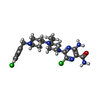

 解析
解析 試料調製
試料調製 電子顕微鏡法
電子顕微鏡法 FIELD EMISSION GUN
FIELD EMISSION GUN
 ムービー
ムービー コントローラー
コントローラー




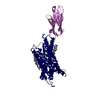



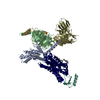




















 Z (Sec.)
Z (Sec.) Y (Row.)
Y (Row.) X (Col.)
X (Col.)
























